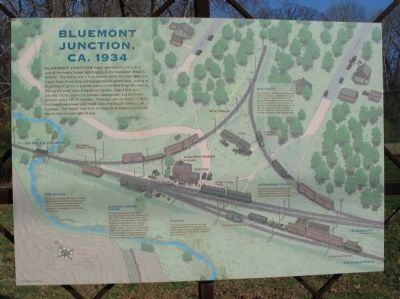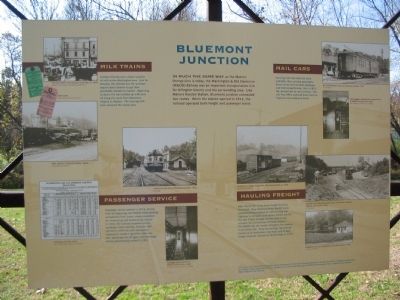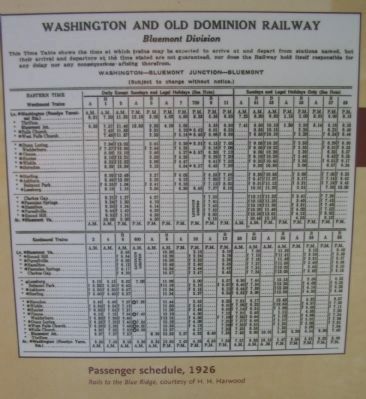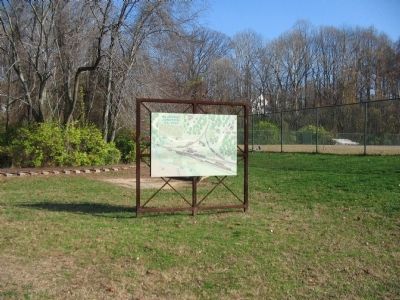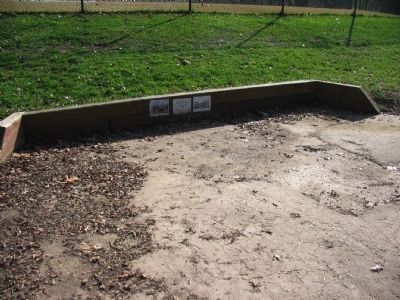Boulevard Manor in Arlington in Arlington County, Virginia — The American South (Mid-Atlantic)
Bluemont Junction, ca. 1934
Bluemont Junction began operation in 1912 as a part of the newly formed Washington & Old Dominion (W&OD) Railway. The station was a busy transfer point for passengers and freight from Alexandria and Georgetown to points west, ending at Bluemont, Virginia - a popular resort in the Blue Ridge Mountains. During the peak years of passenger service, from 1912 and into the 1920s, trains ran between Georgetown and Bluemont Junction every 10-20 minutes. Passenger service ended in 1951, but freight continued until 1968 when the W&OD went out of business. The W&OD Trail from Sherlington to Purcellville follows the former railroad right-of-way.
(Key points of the junction indicated on the illustration):
Wye Track
Trains from three directions met at Bluemont Junction. A triangular pattern of tracks joined at a "Y" (wye), so that freight trains could reverse direction. Electric-powered passenger trains could go backwards and forwards so they did not need to be turned around on the wye. The wye was also used as a holding place for freight cars. Look for a railroad tie from the wye along the side of the dirt road.
The Routes
The Junction connected two routes - a former steam powered line between Alexandria and the town of Bluemont in Loudoun County with an electric trolley service between Georgetown in Washington, D.C. and Great Falls, Virginia.
Electric Power House
Trains that traveled to and from Bluemont Junction were steam powered until about 1913, when overhead electric wires were added to provide power for the engines. Electricity was generated by the railroad's power plant in Rosslyn and transmitted through a series of transformers like the one housed here. You can see the remains of the building foundation - it's the concrete pad to the left of the soccer field. The railroad converted to diesel power in the 1940s.
Station
The wood building attached to the power transformer house served as a passenger and freight depot. From this building a dispatcher also controlled rail traffic, first by telephone and later by radio.
Interurban Trains
Passenger service was handled by one or two car trains that used self-propelled electric coaches known as "combines." Some combines also carried mail and baggage.
(Reverse Side of Marker):
Bluemont Junction
In much the same way as the Metro's Orange Line is today, the Washington & Old Dominion (W&OD) Railway was an important transportation link for Arlington County and the surrounding area. Like Metro's Rosslyn Station, Bluemont Junction connected two routes. When the station opened in 1912, the railroad operated both freight and passenger trains.
Milk Trains
Loudoun County was a major supplier of milk to the Washington area. And for decades, the railroad was the quickest way for dairy farmers to get their perishable product to market. Beginning at dawn, the train picked up milk cans all along the route from Bluemont, Virginia to Rosslyn. The evening milk train returned the empty cans.
Passenger Service
Passenger service peaked in 1919. Almost from the beginning, the W&OD faced growing competition from autos - more convenient for commuting and weekend excursions. In 1941, the railroad stopped running passenger trains. Service, however, was revived in 1943 as a war-emergency measure to conserve gasoline. After the war, patronage fell off again, and passenger service permanently ended in 1951.
Mail Cars
Carrying mail was relatively more profitable than carrying passengers. Some of the cars had both passenger and mail compartments. But in 1951, the railroad lost its mail contract. The U.S. Post Office switched from trains to trucks for short-distance hauls.
Hauling Freight
After World War II, the heavy freight business flourished. Now diesel-powered W&OD trains carried building supplies for new housing and highways in Arlington and eastern Fairfax County. The late 1950s brought another boon to the railroad - the construction of Dulles Airport. The W&OD was the closest railroad to the massive construction site. To do the hauling, the railroad beefed up its equipment, road beds, and bridges. Freight revenues reached an all-time high in 1959.
Topics and series. This historical marker is listed in these topic lists: Industry & Commerce • Railroads & Streetcars • War, World II. In addition, it is included in the Washington and Old Dominion (W&OD) Railroad series list. A significant historical year for this entry is 1912.
Location. 38° 52.376′ N, 77° 7.958′ W. Marker is in Arlington, Virginia, in Arlington County. It is in Boulevard Manor. Marker is on North Manchester Street, on the right when traveling north. Located in the W&OD Regional Trail Park, adjacent to the Four Mile Run City park. Touch for map. Marker is in this post office area: Arlington VA 22205, United States of America. Touch for directions.
Other nearby markers. At least 8 other markers are within walking distance of this marker. Rosslyn Station (a few steps from this marker); The Great Falls Line (a few steps from this marker); a different marker also named Bluemont Junction (a few steps from this marker); The W&OD Railway and Jim Crow Laws (within shouting distance of this marker); Tracks into History (about 500 feet away, measured in a direct line); Civil War Outpost (about 700 feet away); Reevesland (approx. 0.2 miles away); Named Stones (1989) (approx. 0.2 miles away). Touch for a list and map of all markers in Arlington.
